
Modern cosmetology offers a wide range of chemical peels that can solve any cosmetic problem. TCA peeling (trichloroacetic acid) is not widely popular, is prescribed with caution, and at the same time is considered one of the most effective. It acts comprehensively, eliminates serious defects and rejuvenates the skin. In what cases is it worth doing TCA peeling and what do you need to know about its features?
What is TCA peeling
The basis of the TCA peeling cocktail is trichloroacetic acid. The substance has the ability to penetrate deeply into the skin even at low concentrations, and this is its danger. The slightest error in the dosage of trichloroacetic acid can result in a deep thermal burn, the consequences of which are difficult to correct.
TCA peeling is not a cosmetic procedure, but a medical procedure, so it is not recommended to do it yourself. The session should be conducted by a specialist who has experience working with trichloroacetic acid.
How does acid affect the skin?
- TCA cleanses the upper layer of the epidermis well thanks to its powerful keratolytic effect - the acid destroys the bonds between dead cells, exfoliates them and dissolves dirt accumulated in the pores. As a result, the skin looks younger and fresher.
- Penetrating to the middle layer of the skin and burning old cells, the acid starts the process of dividing new ones. This increases the protective function of the epidermis.
- The anti-inflammatory effect is to reduce the secretion of sebum - a fertile environment for the proliferation of microorganisms.
- The destruction of old cells makes new ones work. They increase the synthesis of collagen and elastin - the basis of skin elasticity. Microcirculation and capillary circulation improves, due to which toxins are removed from the skin.
- Antibacterial action helps eliminate pimples and acne.
Types of TCA peeling
During the procedure, a controlled burn of the skin occurs. Depending on its intensity, there are three types of peelings - superficial, medium and deep.
| Type of peeling | TCA concentration | Additional substances | Result |
| Surface | 15% | Citric or ascorbic acid and saponins increase the penetration of TCA into the skin and improve microcirculation | Small wrinkles are smoothed out, the relief is evened out |
| Median | 20% | Lactokines and amino acids improve the ability of cells to produce collagen, increase immune defense and activate regeneration | Penetrates into the deep layers of the epidermis and has a pronounced anti-aging effect (tightens the skin, smoothes out average wrinkles, evens out complexion) |
| Deep | 40% | Saponins and phytic acid reduce the abrasive effect of concentrated trichloroacetic acid and improve skin restoration | Used only in limited areas no more than 1 cm. Eliminates deep cosmetic defects. |
Indications and contraindications
Cosmetologists recommend TCA peeling for people with serious facial skin defects. You shouldn't use it as a way to simply freshen up your appearance. For this, there are gentle superficial procedures with AHA acids, Jessner peeling and other techniques that are less traumatic to the skin. It is advisable to use TCA to eliminate the following shortcomings:
- skin irregularities;
- acne scars;
- medium and small wrinkles as a result of photoaging;
- sun or age spots;
- melasma - a benign pathological disorder of pigmentation (looks like an overgrown mole of irregular shape);
- flat moles;
- stagnant acne spots;
- oily skin, prone to pimples and acne;
- age-related skin changes;
- gray dull complexion.
Before scheduling a session, the cosmetologist examines the patient’s medical record in detail. Sometimes laboratory tests are prescribed to identify possible contraindications.
It is advisable to first consult a dermatologist about skin diseases and the possibility of using TCA peeling.
TCA peeling is contraindicated for the following diseases and conditions:
- exacerbation of chronic ailments;
- feverish conditions;
- current infectious disease;
- microtrauma in the treatment area;
- viral, fungal, bacterial and parasitic skin lesions;
- autoimmune skin diseases (for example, psoriasis);
- spider veins on the face;
- tanned skin;
- pathologies of the heart and blood vessels;
- diabetes mellitus in the stage of decompensation;
- tendency to cramps, allergies and scarring;
- the period of bearing and breastfeeding a child;
- endocrine pathologies (especially the thyroid gland).
The time when the procedure can be performed without consequences is limited to several months - from November to March. This is due to the high risk of pigmentation formation as a result of active exposure to sunlight. TCA peeling is used with caution on aging skin, as it largely loses its ability to regenerate. And this can cause complications in the form of increased pigmentation and prolonged redness of the skin.

TCA peeling should not be performed on women with dark skin.
Peeling is contraindicated for representatives of color types IV-VI according to the Fitzpatrick table (dark, very dark and dark skin, dark hair and eyes).
Advantages and disadvantages of trichloroacetic acid
Before deciding on TCA peeling, you should think about whether it is really necessary and what will be more of it - benefit or harm.
| Advantages | Flaws |
| Highly effective compared to other acid peels | An impressive list of contraindications |
| Solving multiple problems at once | Painfulness of the procedure |
| Use at any age (18+) | Duration of rehabilitation after medium and deep peeling |
| Visual control of exposure time (frost effect) | Difficult to carry out at home without the supervision of an experienced specialist |
| No severe toxic effects | The need for preliminary preparation |
| Speed of implementation | Rapid penetration of acid molecules into the epidermis with the danger of uncontrolled burns if the cosmetologist has insufficient experience |
If we compare trichloroacetic acid with glycolic acid, which is similar in strength, then TCA is a clear loser. After it, recovery takes much longer, complications occur more often. Glycolic acid causes almost no peeling in some patients. However, in TCA's defense, it can be said that in a small concentration it gives the same effect as a highly concentrated glycolic acid.
The advantages of TCA peeling compared to similar cosmetic methods of exfoliation and rejuvenation, of course, include the ability to do with one procedure, which means saving time and money and avoiding unnecessary discomfort.
When choosing a clinic for TCA peeling, be sure to ask about the experience of the cosmetologist and read reviews about the procedure and its results in this particular institution.
The first stage is preparation
Proper preparation for peeling can reduce pain, shorten the recovery period, avoid possible complications and increase the effectiveness of the procedure. You need to start preparing a month before the event. Therefore, it is better to find a clinic in advance and get individual doctor’s recommendations.
Preparation includes avoiding the use of scrubs and any traumatic instrument (brushes, hard sponges) 4 weeks before peeling. During this time, it is recommended to use a cream with sun protection of at least 50 SPF.
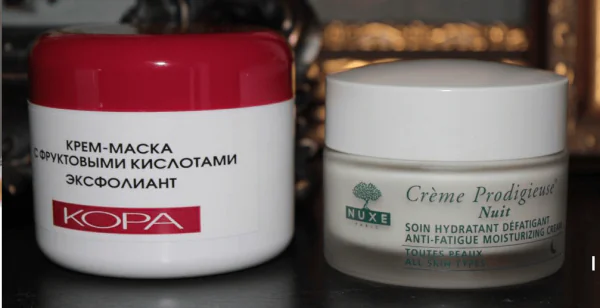
As a preparation before peeling, you need to use creams with an exfoliating effect.
14 days before the session, start using creams containing fruit acids in a minimum concentration. A cosmetologist may even recommend 1-2 superficial chemical peeling procedures with AHA acids. If you are prone to herpetic rashes on the face, taking an antiviral drug a few days before peeling will reduce the risk of their appearance after the procedure. A couple of days before the session, do not go to the bathhouse, sauna, solarium and refrain from removing facial hair.
How is it carried out?
The TCA peeling procedure is the same for all types. Before visiting the clinic, avoid makeup and do not use tonic - its use will reduce the effectiveness of the acid. The first step is cleansing, which the doctor does with a special solution designed to degrease the skin before peeling. Then the drug is applied (the number of layers depends on the type of procedure). The patient feels a slight burning sensation when applying the first layer, the second layer causes pain. They are removed using a fan or fan. Anesthesia is usually not used.
Under the influence of acid, the protein that makes up the surface layer of cells folds and looks like a white coating on the face, reminiscent of frost. Its appearance indicates the effectiveness of the procedure.
Frost is a signal for the doctor to proceed to the next stage - neutralizing the acid with a composition containing soda. The reaction can be quite violent (with hissing), so the neutralizer is also applied in layers. The session ends with washing and applying a cream with an antiseptic, soothing and healing effect.
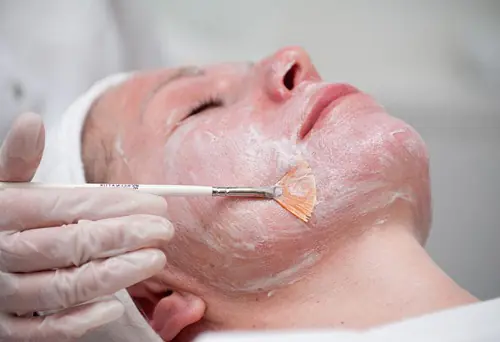
The appearance of a white coating on the skin is a signal to neutralize the acid
The number of sessions is determined by the cosmetologist depending on the condition of the patient’s skin and the scale of the problem that needs to be eliminated. It is recommended to do no more than two procedures per year, although most often the desired effect is achieved after the first. At least two months must pass between them. The results of TCA peeling last for 6–12 months.
The work of a cosmetologist and the peeling preparation itself will cost an average of 5 to 20 thousand rubles (depending on the region and the level of the cosmetology clinic). Add to this price the cost of care products before and after peeling - 7-15 thousand rubles. Thus, the total cost of TCA peeling can range from 12 to 35 thousand rubles.
Self-conducting
For particularly brave ladies who are not afraid of the consequences of home peeling with trichloroacetic acid, there are some tips:
- use only weak 15% acid for home peeling;
- consult with an experienced cosmetologist first and carry out the same preparation as before a session in the salon;
- Prepare everything you need - a bottle of peeling cocktail, degreasing lotion, a weak soda solution, healing cream, paper napkins and a soft washing gel.
- Clean your face of cosmetics with mild soap or cleansing gel.
- Wipe the skin with a degreaser.
- Apply the acid to your face with a brush - first on the forehead, gradually going down to the chin and not affecting the area around the eyes and mouth. Exposure time - no more than 3 minutes.
- Neutralize the acid with soda solution.
- Wash your face with plenty of water and apply healing cream.
When deciding to use TCA peeling at home, remember that the risk of complications is quite high even when it is carried out in a salon by an experienced doctor. Skin care after home and salon peeling is the same.
Skin restoration
After the session, you need to be patient - a completely normal appearance will be restored only after a month and provided that all the doctor’s instructions regarding the care of damaged skin are followed. The first period lasts about a week. A few hours after peeling, redness and swelling appear on the face. This condition lasts for 24 hours. After a day, a thin film forms on the face, which after four days turns into a rather dense crust. It moves away gradually and primarily where the facial muscles move more.
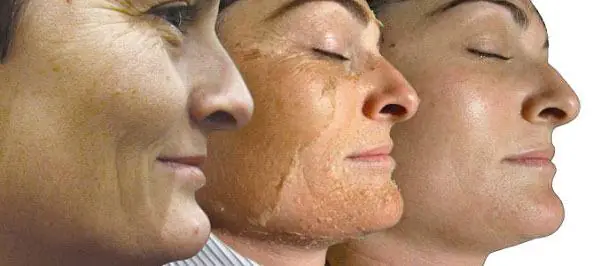
During the first week after peeling, intense exfoliation of the skin occurs.
These days, the skin needs to be supported with sprays, foams or creams with panthenol. You can wash your face no earlier than the second or third day after peeling. To restore the skin, you can use caring serums and moisturizing creams with vitamin complexes.
During the healing period (7–10 days), a sauna (bath), solarium or swimming pool is prohibited. You cannot sunbathe, exercise in the gym, or apply steaming compresses or decorative cosmetics to your face.
Over the next 2–3 weeks, complete cell regeneration will occur. The skin needs to be supported with nourishing and moisturizing creams.
Possible complications and side effects
Severe swelling as a side effect often occurs in patients with a tendency to allergies. To reduce it, you need to take an antihistamine before the procedure.
Redness is a normal skin reaction to a burn. Hyperemia will last 1–3 days until a brownish crust appears. The tightness of the skin after its formation can be so strong that facial expressions and chewing become difficult. Under no circumstances should crusts be removed forcibly.
Complications after peeling:
- Increased skin sensitivity to ultraviolet radiation leads to the formation of post-inflammatory pigmentation. Use a cream with UV protection of at least 50 SPF for six months after peeling.
- The appearance of a boundary between areas of the skin where it was treated with acid. The complication is rare; foundation helps. The defect can be completely eliminated with a Jessner peel.
- White spots on the skin appear only after deep spot peeling using concentrated trichloroacetic acid, which kills melanocytes (cells responsible for pigmentation). Corrected by several superficial peelings with fruit acids.
- Scars may appear in places where the crust was forcibly removed or an extra layer of acid was used to treat a deep defect.
- As a result of increased individual sensitivity to acid, dry skin may persist for a long time with the formation of creases in the form of pseudowrinkles. In this case, a course of biorevitalization or mesotherapy will help.
- The return of acne a short time after peeling may not be related to the condition of the skin and sebaceous glands. In this case, it is worth looking for internal reasons.
- In patients with a tendency to rosacea, redness may persist for a long time (up to a year) due to dilated blood vessels. To reduce it, you need to give up any thermal procedures (sauna, steam bath), increased physical activity, and eliminate spicy foods and alcohol.
After TCA peeling, do not lose touch with your cosmetologist; contact him for advice in any unusual situation during the rehabilitation period. A timely solution to the problem will protect you from the adverse consequences of the procedure.
Reviews of TCA peeling with before and after photos
I don't have shocking before and after photos, sorry. I just don’t bring my skin to this state)) But I feel the need for such active skin renewal, and peeling does an excellent job of this. The skin becomes smoother and the pores are tightened. Fat content is reduced. Naturally, scars and post-acne are smoothed out. The skin looks healthy, glowing from the inside. I can’t say anything about wrinkles due to their absence, but judging by how powerfully the skin is smoothed out, I can say that this will have a very favorable effect on them too - at least they will be smoothed out. After the skin is completely restored, I move on to my usual care (Renophase creams). During the peeling period, it is better to avoid products with retinoids (they loosen the top layer of skin, peeling can penetrate deeper and make the process uncontrollable) and acids.
Tinka-Alevtinka
https://kosmetista.ru/blog/uhodovaya-kosmetika/58665.html
For 3 years I did a winter course of 4-5 procedures (from December to March) at 15% and it was very painful, although they blew it with a fan while applying the layers. By the way, depending on the skin, from 1 to 4–5 layers are applied, and even 6 layers for someone who is very patient, because... The acid burns and tears flow from my eyes. This peeling removes all sorts of age spots well (I had a rather large noticeable spot on my cheek, which was removed in 2 courses). If the skin is porous and oily, then TCA will help to even out the skin. After the procedure, of course, you need to smear your face with a rich cream and moisturize until the skin completely comes off. In the first 2-3 days, depending on the properties of the skin, there will be redness and swelling, which will go away. I have very sensitive skin, the blood vessels are close together, but on the third day (it’s better to do it on Friday, so I can sit at home for 2 days), I always go to work covered in cream.)
Lina
http://www.woman.ru/beauty/plastic/thread/4111230/1/#m33737314
I also went through this procedure in February. I didn’t ask the cosmetologist what the percentage was. I trust her, they (two of them participated in the process) have been working with me for many years. In my case, there was very strong swelling. So I didn’t notice much peeling as such. I was in decent condition within a week. As my son said, “Oh, mom has come home!” Otherwise some Chinese woman has been walking around the house all week.” I will say one thing - I will do it again for sure. In general, I can’t complain about my skin, but my nasolabial lips and horizontal wrinkles on the forehead have smoothed out, as well as between my eyebrows. I’m happy - I can put off Botox for now.
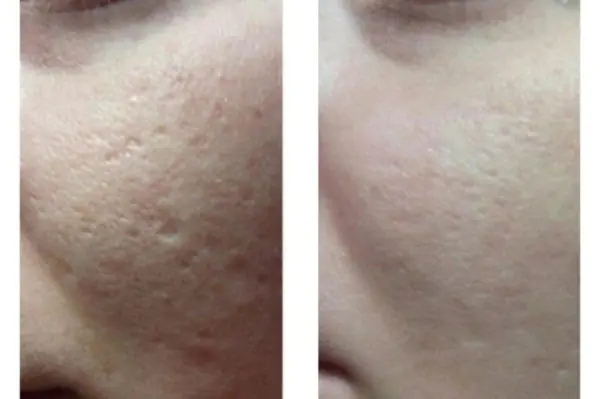
TCA peeling effectively smoothes the skin surface
Natalia
https://www.babyblog.ru/community/post/krasota/3074469
TCA peeling is a fairly radical and equally effective way to improve your appearance. It is most suitable for ladies from 25 to 45 years old. But if it is possible to get by with other means, it is better to refuse a painful and unsafe procedure.
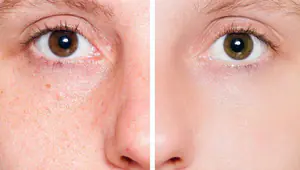
One of the most common procedures offered by cosmetologists in all beauty salons are various types of peelings. They are extremely popular among the fair sex, since they are presented almost as a panacea for absolutely any skin problem. Chemical methods of facial cleansing have been used in cosmetology for many decades, helping to solve problems of various kinds: from getting rid of acne to facial rejuvenation and improving skin structure.
Very often in the list of services at a beauty salon you can find the name “tca peeling”, otherwise it is also called “trichloroacetic acid peeling”. Let us examine in detail what this method of skin cleansing is, who it is suitable for and what problems it copes with.
TCA peeling - what is it?
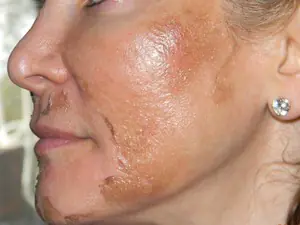
Trichloroacetic peeling is a variant of chemical cleansing of the skin, the main active ingredient of which is trichloroacetic acid. This is a chemical compound of organic origin. It easily dissolves in water, can easily penetrate the layers of the dermis and has bactericidal, anti-inflammatory, cauterizing properties. Is a toxic substance.
The main mechanism of action is as follows: acid molecules are easily absorbed into the deep layers of the epidermis, protein coagulation occurs and intercellular connections are destroyed. Due to this, the dying and exfoliation of the stratum corneum occurs. Along with dead cells, sebaceous plugs and micro-pollutants that clog pores are removed. At the same time, active division of new cells occurs in the deep layers, and the recovery process begins. At this moment, a slight soft tissue burn is visually observed. But after a couple of days, the injured areas are replaced by new healthy epidermal cells.
Attention! The procedure is extremely dangerous to carry out independently at home. Failure to comply with safety rules, hygiene of the session, errors in the concentration of the drug and the length of exposure time can lead to serious health problems and damage the skin forever.
Feasibility of application
The main task of any peeling is to correct cosmetic defects of the skin. When making an appointment with a cosmetologist for this type of care, patients expect to receive:
- qualitative change in the appearance of the skin (smoothness, dullness, healthy complexion, etc.);
- correction of pigmentation and post-acne;
- stabilization of the sebaceous glands and restoration of pH balance;
- lifting effect and tightening of facial contours;
- rejuvenating effect and relief smoothing.
However, TCA medium peeling is primarily a medical procedure, the use of which has a list of specific indications. Most often, to prescribe this type of chemical exposure, the presence of several problem conditions is necessary.
Indications and contraindications for the procedure
The procedure is recommended if:
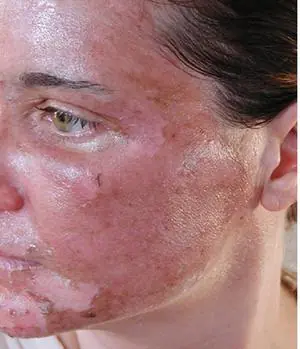
obvious skin defects after chickenpox and acne (scars, pits, post-acne, scars);- hyperkeratosis (unnatural thickening of the skin);
- excessive pigmentation, including freckles;
- skin atrophy in the form of stretch marks (stretch marks);
- small facial wrinkles;
- excessive work of the sebaceous glands, acne;
- enlarged pores, presence of comedones;
- flat birthmarks, nevi;
- melasma;
- change in tone and elasticity.
- dull complexion.
During the consultation, the specialist is also obliged to familiarize the client with the existing restrictions for performing the session.
The procedure will be refused if the following contraindications are present:

the presence of chronic diseases in the acute stage, as well as oncology;- diseases of the endocrine system, including thyroid disease;
- damage by bacterial or parasitic infections (skin mites, streptoderma, impetigo, etc.);
- there is a fungal infection of the skin;
- active inflammatory processes in the treated area;
- ARVI, acute respiratory infections, herpes and other infectious diseases;
- acne treatment with acnecutan and roacquant;
- pronounced rosacea;
- keloid scars;
- vitiligo and pigmentation of large areas of the affected area;
- fresh tan;
- allergic reactions to the composition of the exfoliant;
- pregnancy or lactation period;
- had a negative experience with microdermabrasion and peelings before;
- the presence of wounds, microtraumas of the skin, recent piercing or tattooing;
- clients with phototypes 4-6 according to the Fitzpatrick gradation.
Types of TCA peels
Used in cosmetology solutions of various concentrations. Depending on the percentage and exposure time, the depth of exposure to the skin will differ. Based on the degree of concentration and time of exposure of the drug, it is customary to distinguish between two types of peeling - superficial and medium.

TCA 15 peel means the use of 15% trichloroacetic acid, and the degree of action of the procedure is considered a superficial peel. This is a gentle type of chemical peeling that affects the surface layers of keratinized cells of the epidermis and provides superficial cleansing. In this case, the exposure time on the skin will not exceed 10-15 minutes. But in terms of effectiveness, such a session is superior to the widely used milk, apple, wine, and glycolic AHA peels.- Medium tsa peeling. A more concentrated solution of trichloroacetic acid is used for medium peeling. A saturated 20-35 percent reagent is applied to the surface of the skin and left for 20-30 minutes. As a result of this use of acid, an artificially created chemical burn is formed on the surface of the skin, the degree of which is controlled by a competent specialist. The medium peeling itself is more painful, but the effect of such cleansing is much more noticeable.
- Deep peeling using TCA 40% is not performed due to the high risk of adverse consequences. However, sometimes it is practiced to apply an exfoliant locally to individual areas of the skin, for example, to get rid of benign formations or cosmetic defects.
You need to know that the degree of effect on the skin also depends not only on the concentration of the active substance, but also on parameters such as the number of layers applied to the skin, exfoliation time, additional use of compounds with resoricin, glycolic or salicylic acid. An important role is played by the condition of the patient’s skin before the procedure (presence of minor damage, wounds), as well as pre-peeling preparation.
How to prepare your skin for peeling
Cleansing the skin with trichloroacetic acid is quite a serious medical procedure, for the favorable implementation of which it is necessary to carry out a number of simple measures in advance. The effectiveness of the result, reducing the rehabilitation period and minimizing the risk of complications will depend on this. So, what subtleties need to be taken into account?
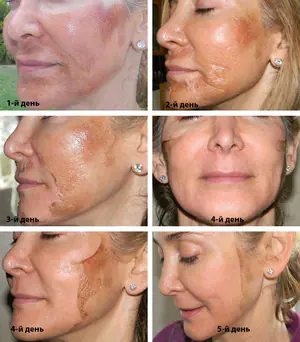
Correct timing. The most optimal time for the procedure will be from the end of October to the beginning of March. In the autumn-winter period, there is much less solar ultraviolet radiation, which can harm the skin and cause hyperpigmentation.- A month before the scheduled event, do not use additional skin cleansers. Eliminate scrubs, gommage, brushes, sponges and sponges from daily use.
- Perhaps the cosmetologist will recommend peeling with AHA acids 2-3 weeks before the procedure.
- Start using cosmetics with fruit acids and sunscreens a couple of weeks before TSA peeling.
- Avoid visiting the solarium, sauna and bathhouse in advance. Postpone eyebrow correction, tattooing and hair removal of the mustache area until the skin is completely restored after peeling.
- To reduce the risk of viral and herpes infections, start taking antiviral medications 5 days before your mid-peel.
- Sometimes it is advisable to use medications that help strengthen capillaries and blood vessels. This will contribute to the rapid restoration of damaged tissues during the rehabilitation period.
Skin care during the recovery period
For skin restoration and rehabilitation After exposure to trichloroacetic acid, a long period is required. Over the next 4-5 weeks, careful and careful care will be required. Damaged skin needs protection from adverse environmental factors, protection from overdrying, dehydration and exposure to pathogens. In addition, for the best results, assistance in activating regeneration processes is necessary.
The entire rehabilitation period can be divided into stages.
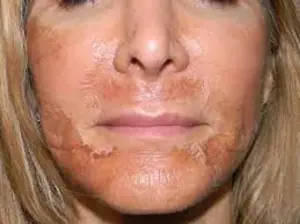
Medium peeling is a manipulation after which significant redness and swelling form on the skin in the first day. You may feel discomfort, tightness and dryness. This condition often lasts for two to three days. A thin film forms on the surface. On the fourth day, the face becomes covered with a dense crust. Under no circumstances should you touch the crust with your hands or try to scrape it! This can lead to infection or injury to the skin before a scar appears.
To alleviate the condition, the cosmetologist will prescribe the necessary moisturizing creams, which will include vitamins, hyaluronic or mandelic acid. In the first two days, using water or any other means to wash your face is strictly prohibited. All liquids will have to be consumed using a straw. Dairy products are excluded from the diet and green tea.
Then the resulting crust will begin to actively peel off, and the exposed skin will noticeably darken. This stage will last about a week. Then all discomfort will disappear.
At the rejection stage it is important:
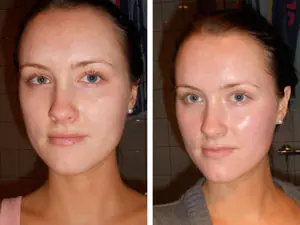
protect your face from exposure to sunlight and ultraviolet radiation;- refuse to visit the sauna, swimming pool and bathhouse;
- do not expose the skin to high and low temperatures;
- do not apply compresses or masks;
- take a break from active physical activity;
- do not wear makeup or use decorative cosmetics.

Over the next 2-3 weeks, the skin is completely replaced. Metabolic processes are restored, local immunity is increased, and the rejected epidermis is completely replaced by new young cells. Elastin and calogen fibers are remodulated. Skin appearance is also undergoing changes. The face becomes smoother, the texture is smoothed out, wrinkles and skin defects are less noticeable. Exfoliated cells reveal fresh, rejuvenated and healthy skin.
Care during this period should combine maximum hydration and nutrition. A useful procedure would be mesotherapeutic biorevitalization using hyaluronic acid. This will help restore hydrobalance, elasticity and skin turgor.
Frequency of procedures
Facial cleansing with TCA peeling medium impact gives noticeable results even after a single use. The effect after the procedure can last a significant period of time: from six months to a year. If necessary, a repeat procedure is possible after the end of the recovery stage, but not earlier than after 4 weeks. In this case, it is important to have time to do both sessions in the autumn-winter period.
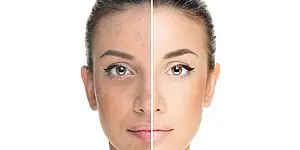
“Everything in a person should be beautiful: face, clothes, soul, and thoughts,” these are the words from the famous play by A.P. Chekhov's "Uncle Vanya". To make their faces beautiful, girls and women resort to a popular service today - TCA peeling.
This chemical cleaning method is quite popular, but not everyone knows what it is.
What is it - chemical, complex
The peculiarity of this method is the use of trichloroacetic acid. The first research in this direction began in the mid-20th century. The name of the method (TCA peeling) comes from the abbreviation of the term trichloroacetic acid (trichloroacetic acid or tca acid).
There are several types of TCA peeling, based on the depth of action of the acid:
With this dry cleaning option, different concentrations of acid can be used: 10%, 20% or 30%. The choice has a significant impact on the speed of the procedure and the depth of penetration of the acid solution.
Mechanism of action, effects
The mechanism of action of trichloroacetic peeling is the destruction and removal of damaged cells. Young cells are formed, and the pressure of those located in the basal layer is also stimulated.
The effectiveness of cleaning depends on many factors, for example:
- depth of action of TCA acid;
- number of layers;
- type of solution used;
- use of other substances;
- the nature of the preparation that is carried out before the session.
Carrying out the procedure allows you to achieve good results. They are due to the properties of TCA acid. Among the most significant are the following:
- keratolytic (softening and removal of the upper layers of the epidermis);
- lifting (increasing the effect of collagen or elistin);
- antioxidant (provides the connection of heavy metals and neutralizes free radicals, which guarantees the protection of the epidermis from the negative effects of the external environment);
- comedolytic (opening of clogged sebaceous ducts and glands, smoothing out wrinkles);
- whitening (as a result of removing dead layers of the epidermis, which ensures smoothing and whitening);
- antiseptic (pathogenic microflora that penetrates the skin pores is destroyed).
The popularity of TCA peeling is due to a considerable list of positive effects that can be achieved after it.
Advantages and disadvantages
Peeling with trichloroacetic acid has a number of advantages, including the following:
- Safety. The use of trichloroacetic acid during the procedure almost completely eliminates the possibility of an allergic reaction.
- Denaturation of proteins. High-quality and uniform bleaching of the epithelium is ensured, which became possible thanks to a clear delineation of the depth of exposure to the acid solution.
- Uniform distribution of acid.
- Simple and short preparation.
- Short-term procedure.
- Fast recovery period.
- When using a 15% acid solution, there are no many restrictions for the procedure.
In addition to the advantages, the method also has some disadvantages:
- Large list of contraindications.
- The rapid penetration of acid makes it difficult to accurately determine the depth of penetration.
- There is a high probability of pain during the procedure.
- When using 20% or 30% TCA acid, the possibility of peeling during the rehabilitation period cannot be excluded.
Following the recommendations of specialists and their professionalism allows you to smooth out the disadvantages of the procedure.
Indications and contraindications
To carry out the procedure, a certain list of indications is required. Among them:
- Presence of skin irregularities.
- The appearance of thickening of the stratum corneum of the epithelium.
- The appearance of small and medium wrinkles.
- The presence of scars formed at the site of acne.
- Freckles of various etiologies.
- Birthmarks with a flat surface.
- Violation of pigmentation of the integument.
- The patient has oily skin, which leads to acne.
- Dull skin on the face.
- Loss of skin elasticity.
- The presence of stretch marks on the body.
- Pore expansion.
In addition to the indications, specialists must take into account whether patients have contraindications to TCA peeling. Among the most significant are the following:
- The presence of diseases at an acute or chronic stage of development.
- Acute respiratory viral infection.
- Fever.
- The patient has diseases for which treatment involves the use of Roaccutane.
- Fresh injuries or other damage to the skin localized in the area of dry cleaning.
- Cuperosis.
- Pregnancy or breastfeeding.
- A disease that requires radiotherapy.
- Fresh tan.
- The presence of acute inflammatory processes caused by diseases such as dermatosis, herpes.
- The patient's skin is prone to forming colloidal scars.
- Conducting another type of skin cleansing less than 7-8 weeks ago.
- Mental illnesses.
- Hypertrophic disease.
- Photodermatitis.
Skin sensitivity, hypertrichosis, menstruation are relative contraindications.
Types of procedure
The classification is based on the concentration of the acid solution (%) and the depth of its effect. Examples are shown in the table.
Type of peeling| Solution concentration | Effect | |
|---|---|---|
| Surface | 15% | Dead epithelium is exfoliated, shallow wrinkles are smoothed out, minor skin damage disappears |
| Average | 20% | Nutrition and rejuvenation of the skin |
| Deep | 30% | The top layer of epithelium is removed, which has a rejuvenating effect in case of severe age-related changes |
Deep peeling is recommended for patients in the absence of contraindications. It is considered a rather painful type of chemical skin cleansing.
How is it carried out?
The most convenient time to perform cleaning is from October to March. This is due to the fact that during this time the tissues are in a state of relative rest, and after March active renewal of the epithelium begins, which will help improve the rehabilitation period.
Before dry cleaning, some simple preparation is required. It consists of performing skin cleansing with glycolic acid. After it, the patient is recommended to use creams containing fruit acids for 14–21 days.
If it is not possible for the patient to avoid or minimize time spent in the sun, it is recommended to use creams with sunscreen properties to protect the skin.
Thanks to such manipulations, it will be possible to strengthen the walls of tissue blood vessels, which will speed up the recovery process after peeling.
For 30 days before cleaning, it is recommended not to use scrubs, washcloths, or sponges. It is also better to avoid performing such actions as eyebrow shaping, visiting baths, saunas and solariums.
In order to minimize the possibility of developing herpes, 3-5 days before cleaning, the patient should start taking medications that have antiviral properties.
Upon completion of the preparatory period, you can begin trichloroacetic peeling. The procedure consists of the following steps:
- Cleansing. The skin is pre-cleansed of makeup. It is not recommended to use a tonic for this, as this may reduce the effectiveness of the acid solution. The specialist carries out the cleansing himself, using special products with a degreasing effect.
- Application of TCA acid. The acid is applied evenly in several layers. The specialist selects the concentration of the acid solution depending on the type of procedure and the desired cleaning result. After applying the 2nd layer, the patient experiences discomfort associated with the onset of the acid’s action. To reduce discomfort, specialists use a fan, the air flow of which is directed towards the skin cleansing area. The effectiveness of the procedure is indicated by the appearance of a white coating on the surface of the skin.
- Neutralization. The essence of this stage is to neutralize the acid solution. This is necessary in order to prevent the possibility of negative effects from acid residues. For this purpose, neutralizers are used, which are also applied evenly in several layers. After this, the skin is thoroughly washed with clean water to completely remove the acid and neutralizer.
- Finishing cleaning. At the final stage, a cream with antiseptic, anti-inflammatory and moisturizing properties is applied to the skin.
The duration of cleaning with trichloroacetic acid ranges from 20–30 minutes.
The rehabilitation period is no less important than the procedure itself. Following the recommendations of skin care specialists after TCA peeling will help consolidate the positive results of cleansing, as well as speed up the process of tissue regeneration.
This can be achieved by using a complex of targeted drugs, for example:
- promoting the formation of a translucent film on the skin;
- preventing the negative effects of sunlight;
- having antioxidant, anti-inflammatory and vasoprotective properties;
- stimulating the skin restoration process;
- reducing the level of skin sensitivity;
- antiviral drugs.
The duration of the post-peeling stage ranges from 14–16 days.
For 2 weeks after the procedure, it is not recommended to sunbathe, visit the sauna, solarium, bathhouse, or use decorative cosmetics, scrubs and masks.
Results, before and after photos
The results of TCA facial cleansing can be seen in the before and after photos, including the results by day:
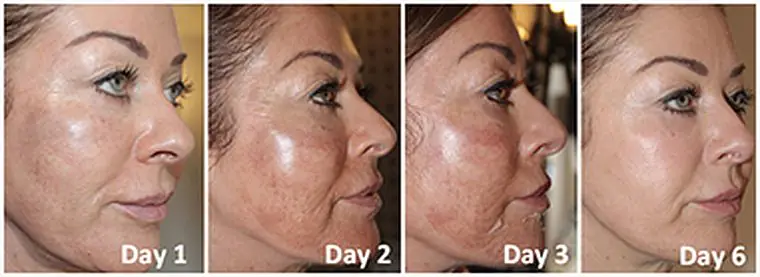
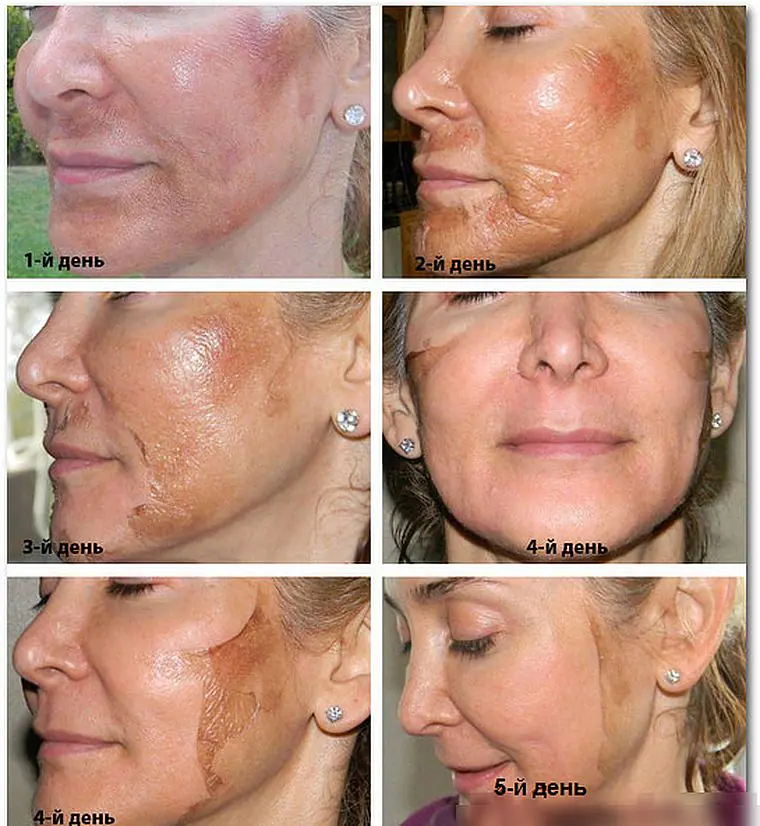
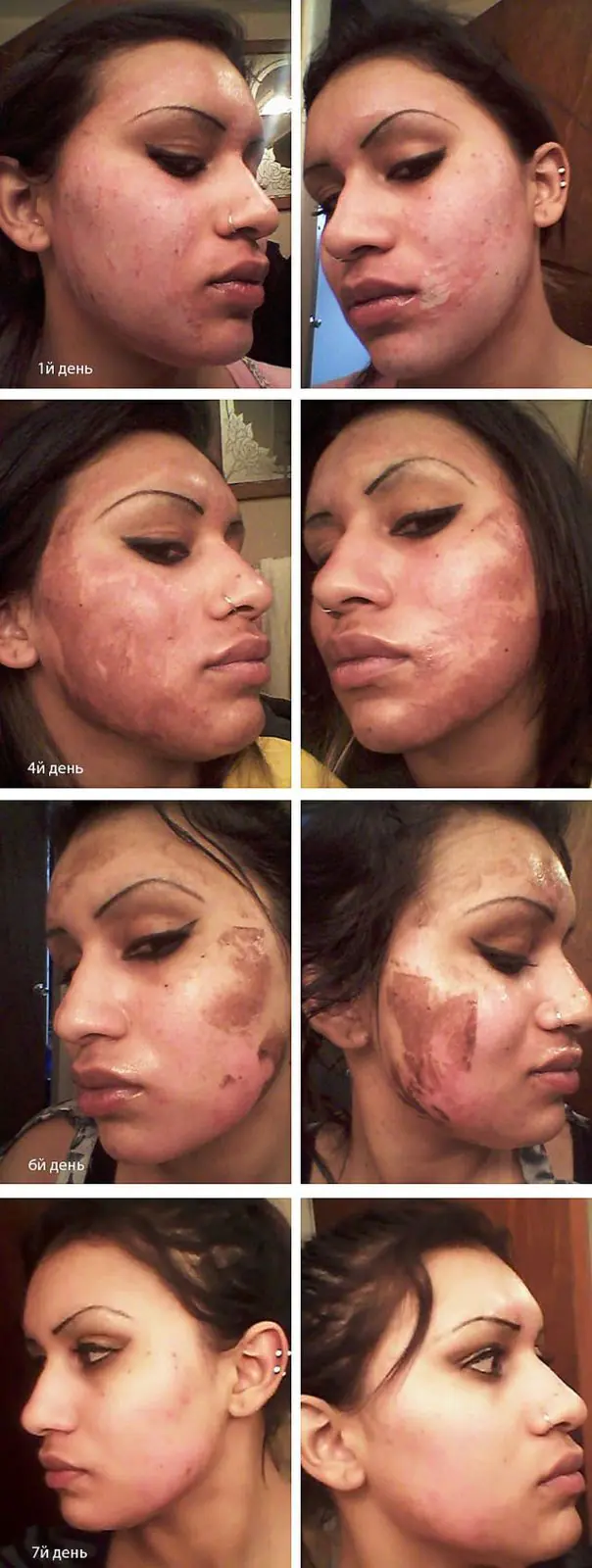


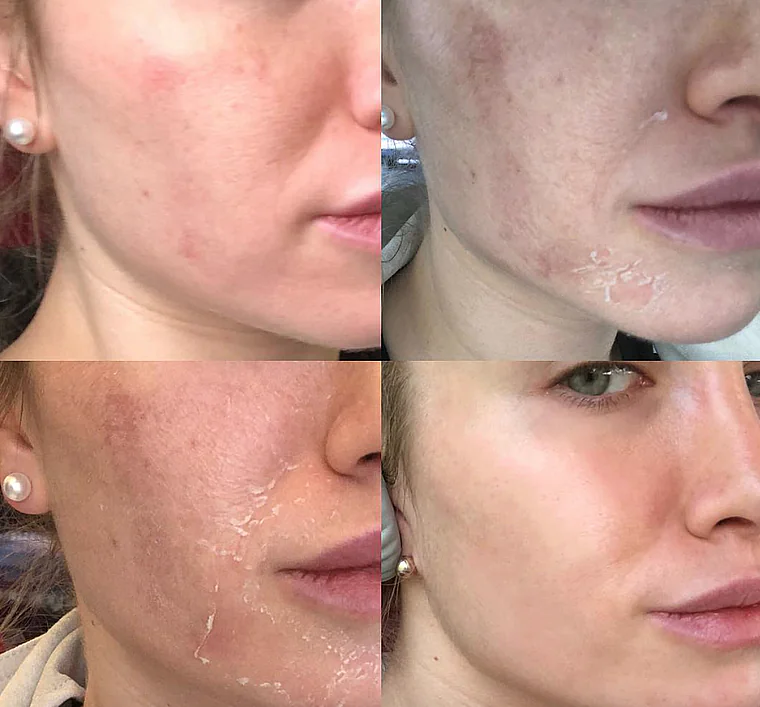
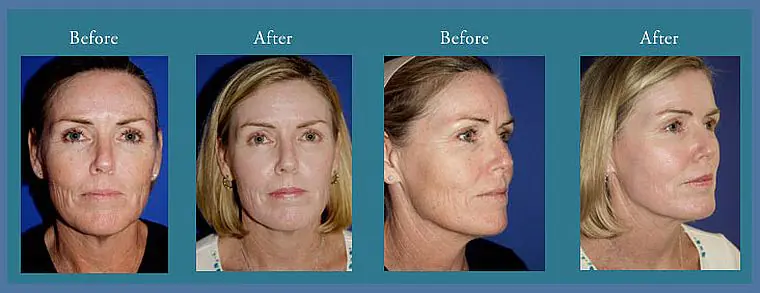
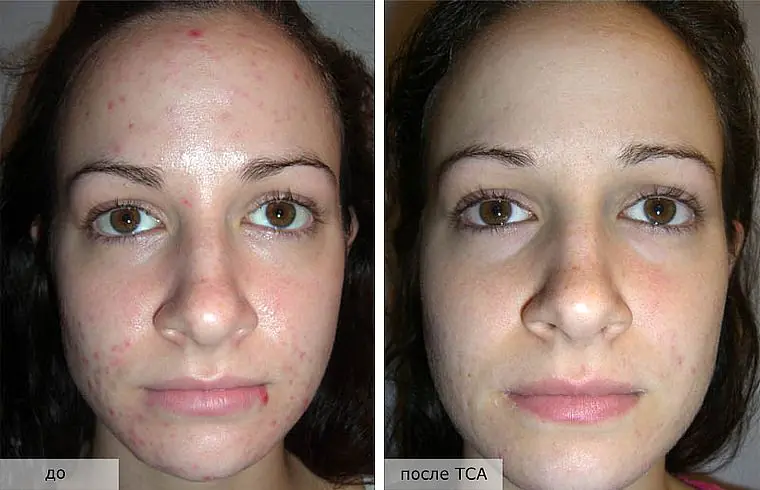
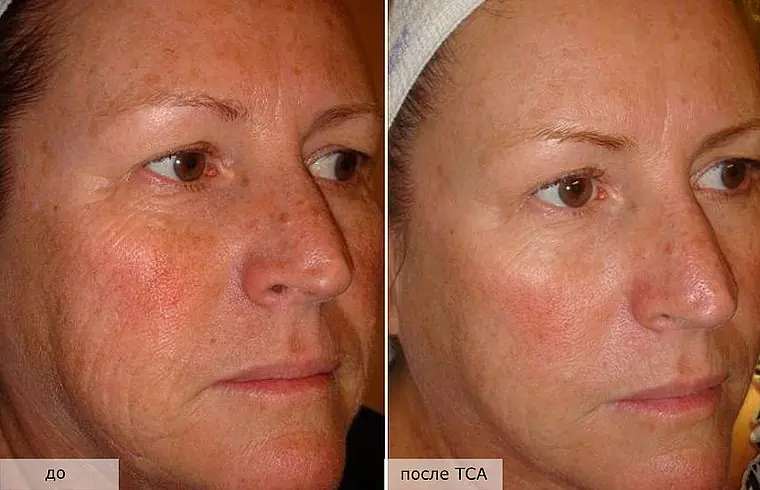
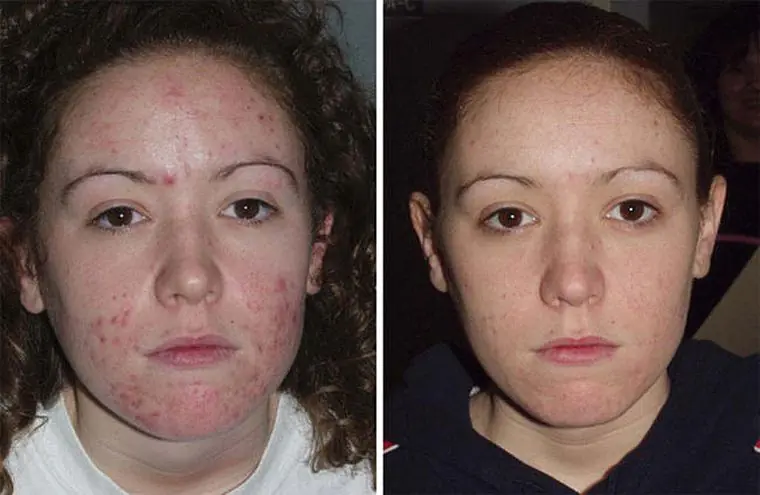
Possible side effects, complications
After TCA peeling, the possibility of complications cannot be ruled out. As a rule, they become noticeable within 2–3 days:
- redness of the treated area;
- peeling;
- swelling;
- darkening of treated areas;
- increased skin sensitivity;
- allergy;
- marbling of the skin.
If complications do not go away within 3-5 days, it is recommended to consult a specialist.
Answers to popular questions
Experts recommend performing a deep peeling course no more than once a year. Otherwise, the possibility of unexpected side effects cannot be excluded.
Superficial and medium peeling – 1-2 courses every 1-2 months.
You cannot conduct the course more than once every six months.
The chemical cleaning procedure involves trauma to the skin. This is necessary to ensure the possibility of starting the process of rejuvenation and regeneration of the epithelium. The result will become noticeable after 2-2.5 months, when the skin is completely restored.
This problem may occur after spot removal of scars using TCA acid (30%). After 1–2 months, the spots will gradually begin to lighten and then disappear completely.
The possibility of complete destruction of the cells responsible for skin pigmentation cannot be ruled out. In this case, the stains will remain forever.
Each patient's skin reacts to peeling differently. The possibility of increased sensitivity and dryness of the skin cannot be ruled out. This is due to insufficient moisture in the epithelial layer. The situation can be corrected with hyaluronic acid injections or mesotherapy.
The average cost of TCA peeling is 5000-8000 rubles. The determining factors are the number of procedures and courses, the area of the zone, and the concentration of the acid solution.
Reviews
The procedure is very effective, especially in cases where there are problem areas of the skin. But don't forget about daily skin care. Otherwise, you will have to resort to trichloroacetic peeling more than once.
Elena
I performed peeling with trichloroacetic acid a year ago. I plan to repeat the procedure again. I was pleased with the results: the skin on my face became taut, firm and elastic.
Olga
My main problem is freckles on my face. I am 54 years old. Last year I performed the TCA peeling procedure. The freckles have completely disappeared. Why didn't I do this type of cleaning earlier...
Catherine
I have been working with trichloroacetic peeling for 2 years now. Both I and my patients are completely satisfied with the results. There were no complaints from patients.
Arina Vasilievna
I consider dry cleaning using trichloroacetic acid to be the most effective today. Side effects in patients after the procedure occurred only if they violated my recommendations.
>



